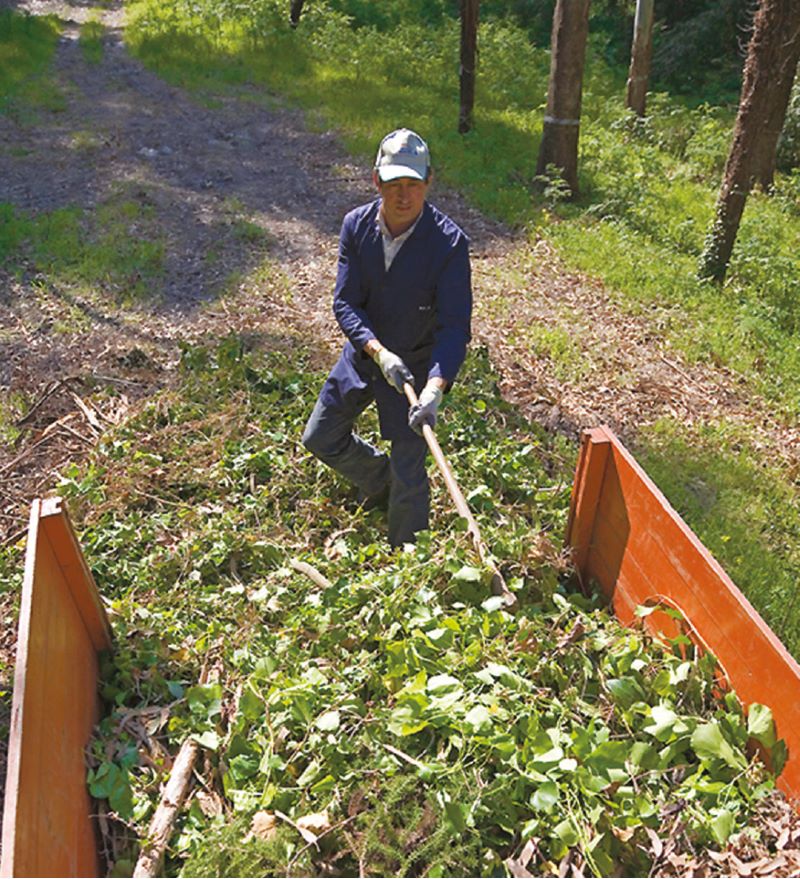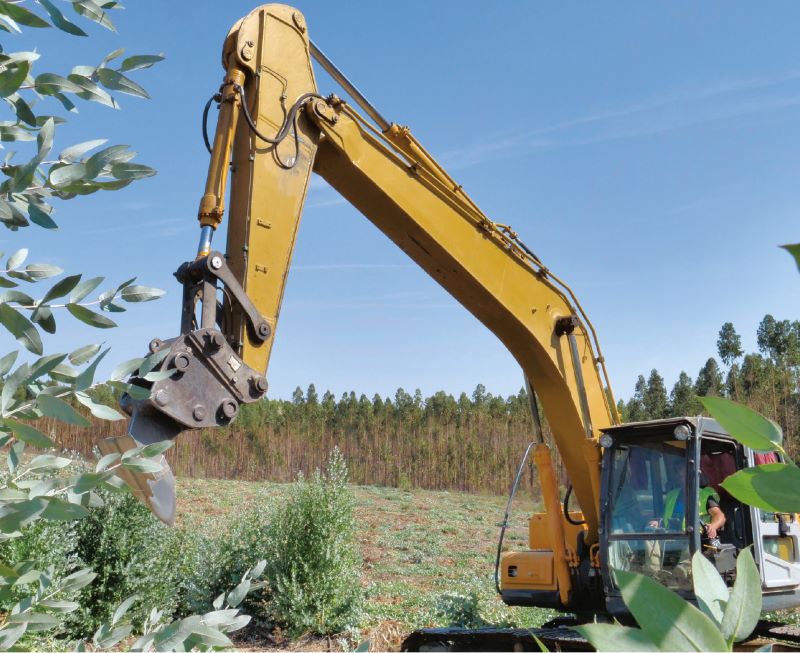When we think of The Navigator Company, we think of factories and paper manufacture: an industrial powerhouse. But the Company has a less visible side, one that the untrained eye might miss: its forestry operations. Navigator is Portugal’s largest private sector forest owner and manages a total of 110 thousand hectares, scattered over 165 municipalities, up and down the country. The management of these holdings is entrusted to the Forestry Production and Operations teams, divided into four coordination zones (North, Centre and Interior, Tagus Valley and South). In conjunction with the Forestry Protection department, they plan and organise the whole cycle of forestry operations, from planting through to felling, including management of vegetation to reduce the fire risk. At critical times of year, the whole division is on stand-by to help in fighting fires.
When we think of The Navigator Company, we think of factories and paper manufacture: an industrial powerhouse. But the Company has a less visible side, one that the untrained eye might miss: its forestry operations. Navigator is Portugal’s largest private sector forest owner and manages a total of 112 thousand hectares, scattered over 166 municipalities, up and down the country. The management of these holdings is entrusted to the Forestry Production and Operations teams, divided into four coordination zones (North, Centre and Interior, Tagus Valley and South). In conjunction with the Forestry Protection department, they plan and organise the whole cycle of forestry operations, from planting through to felling, including management of vegetation to reduce the fire risk. At critical times of year, the whole division is on stand-by to help in fighting fires.
Forestry expertise and management
The Navigator Company working forests consist mostly of eucalyptus (81 600 hectares), but the Company also manages a significant area of cork oaks 1 600 hectares) and pine (3 000 hectares). Irrespective of species, forestry management plays a crucial role in preventing fires. There are three fundamental aims here: first, to avoid fires from happening, second, to stop them spreading and, third, to avoid them causing significant damage when they spread.
It is crucial to suspend normal forestry operations to avoid fires caused by machinery on days where the meteorological risk is severe. And vegetation management is also vital to minimising the effects of fires. “In unmanaged woodlands, the undergrowth thickens, providing a pathway for flames to reach the crowns of trees, and the fires get out of control”, explained José Vasques. “To avoid this scenario, forestry officers identify critical situations well in advance, in order to reduce the fuel load and cut vertical communication.” On their visits to woodlands, forestry officers identify areas where the vegetation has started to grow, and this is then cut back by machinery or using handheld motorised equipment, or in some less significant cases, by applying herbicides.
When spring comes to an end, the teams shift their focus and then concentrate on maintaining paths and fire breaks. This is no easy task: the holdings managed by Navigator contain forest pathways totalling around 17 thousand km. The technical staff in each Coordination Area check the entire length of all these paths, to detect any damage caused by rainfall during the winter, and repair work is carried as necessary. This is the only way to ensure that all areas are accessible in the event of a fire.
“Our job is to ensure that the forests are accessible and to reduce the fuel load so that, in the event of a fire, fire fighters can arrive quickly and take safe and efficient action”, José Vasques told us.
The teams have several forestry officers, responsible for the task of identifying areas for intervention. Each officer is assigned an area, which is his or her sole responsibility. Because of their constant presence in the field, they know the holdings better than anyone, and this is extremely important. In addition to the lie of the land and the access routes, they know the neighbours and the local set-up (producers’ association, municipalities, fire services, police stations…).
Many of them have worked for the Company for 15, 20 or even 25 years, always on a very local basis, they are uniquely familiar with their territory and the fire events which have occurred over time in it. “Because, usually, there’s a pattern to fires”, explains José Vasques, “and that knowledge of past events can help us to find the best way to optimise intervention in woodlands. When we intervene in the field, a whole lot of preparatory work goes into it, and knowledge of the past. The forestry officers know that ignitions have occurred at a given place in recent years, that the wind usually behaves in a particular way, and so it’s important to stay ahead with corrective measures to protect our properties. That’s called efficiency. It’s understanding how to spread the largest positive effect from prevention. The local knowledge
from our teams is vital, because with the population drain away from interior areas, there are less and less people who know the land and care for woodlands. In other words, you hear about fires all summer long, but year-round there are not many people in the forests. And the whole logic of forestry means that management, prevention and fire-fighting have to be integrated into an annual system”.
Closer ties

An important part of the task of prevention and preparation consists of communicating and integrating with other organisations involved. Navigator sits on municipal wildfire defence committees, where its views are heard and it helps in setting priorities for intervention and optimising prevention work in the field and the municipal fire-fighting resources.
“We must create and build stronger ties with other organisations”, said José Vasques. “Because we can’t do this on our own. If we all focus on moving in a given direction, if we grow closer and cooperate more, it’s obvious that the end result is optimised and better for us all. So that’s what we do, with the municipal councils, with the forestry associations, with the fire brigades… It’s much easier to work with people you already know, when you speak the same language and know how each other work, than working with someone you don’t know, who might arrive with the best intentions, of course, but the lack of familiarity means you can’t get straight down to work and get things done efficiently and effectively.”
Summing up, José Vasques pointed to three key factors for successful prevention: “A long-term presence in the field and detailed knowledge of the land over time, identifying the work needed and getting it done in advance. Cultivating good relations with different sectors of society and organisations, because it’s important for us all to speak the same language. And technical expertise. If we do all this and join up all the pieces, at the end of the season we have a better chance that this will work well and the damage will be less severe.”
Forest management is fundamental

Instead of seeking to draw connections between the fires and one or more particular species, woodlands need to be managed with care. Scientific research, and experience in the field, show that under-managed woodlands accumulate fuel and react to fire in a very similar way, irrespective of the species of tree.
So in woodlands which are not properly cared for, the number of ignitions is higher, whilst in eucalyptus plantations under professional management, they are less frequent, and their consequences are less severe. The area burned in plantations under professional management, owned by companies in the eucalyptus sector, has been less than 1% of the total area under management. Active management – i.e. with teams in the field, clearing undergrowth and caring for forests – significantly reduces the risk of fire. With that aim in view, The Navigator Company invests around three million euros each year in wildfire prevention and control.

“We often observe that the structural prevention work leaves opportunities (fuel management strips, paths, etc.) that fire-fighters fail to exploit because the teams are unfamiliar with the territory. Because we have an integrated vision, in areas under The Navigator Company’s management, we seek to monitor and support fire-fighting operations to take full advantage of prevention work. This vision is a massive advantage offered by the existing organisation.”
Navigator’s forestry management
110 425 hectares total woodlands
81 600 hectares of eucalipto
1 600 hectares of cork oak
3 000 hectares of pine
900 hectares of other species
12 070 hectares of conservation areas
8 500 hectares of infrastructures
2 755 hectares in other use
Prevention in 2018
3,34 M€
average amount (total) invested in FFD (Forest Fire Defence), of which:
2 M€
approximate amount investment in prevention in 2018, of which:
1,05 M€
vegetation management and clearance in 9 500 hectares
290 000€
maintenance of driveways totalling 3 150 km